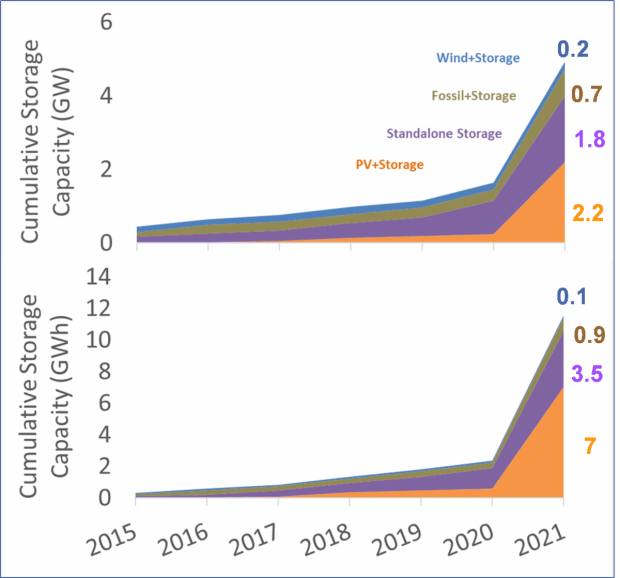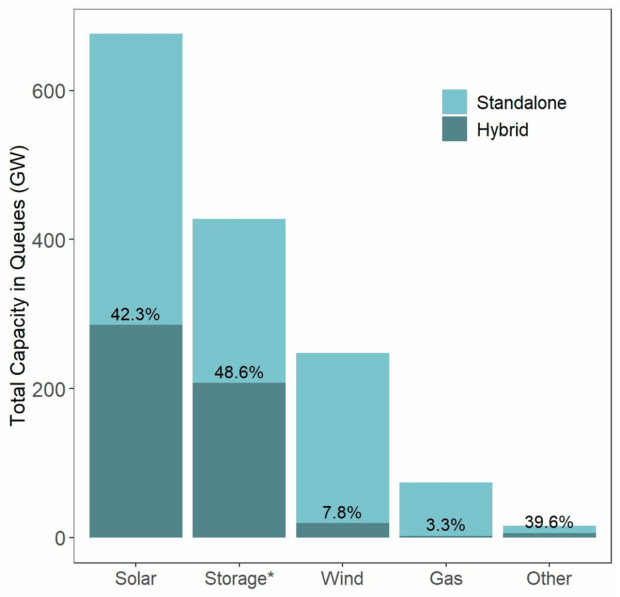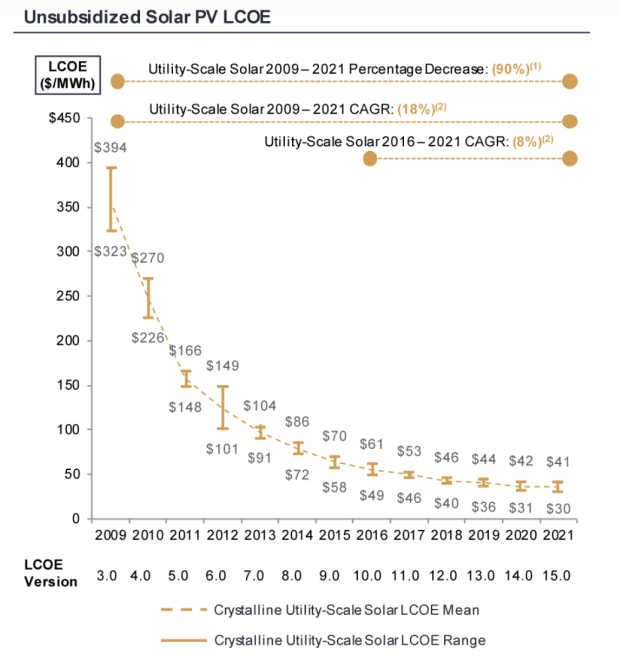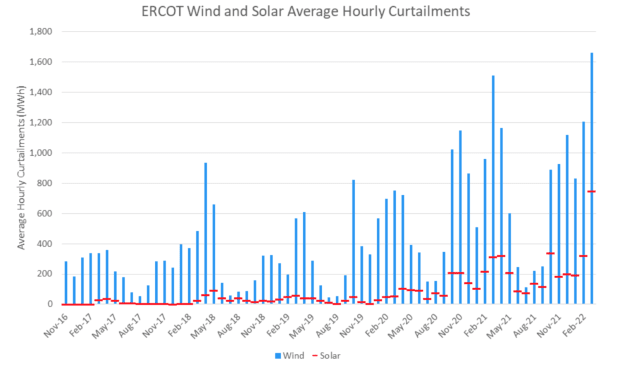Bitcoin miners now have a lucrative opportunity as the trend in pairing batteries with solar energy plants accelerates.
This is an opinion editorial by Ali Chehrehsaz, a mechanical engineer with 16 years of experience in the energy industry.
This article will outline how collecting solar energy and storing it can provide a powerful dynamic for bitcoin mining operations by outlining that:
- Hybrid power plants that pair electrical generation, especially solar, with batteries are growing rapidly
- Bitcoin mining will be incorporated in these plants alongside batteries, for the same reasons
- Incorporating bitcoin mining as well as batteries requires proper sizing of deployed assets, and also splitting energy between batteries, mining and the grid in a way that optimizes revenue
- The path forward will not be technically or commercially simple, but the opportunity is massive
Hybrid Power Plants
There is a new breed of power plant on the rise: batteries are being co-located with wind, solar photovoltaic (“PV”), fossil fuels, etc. to create what are referred to as “
The briefing goes on to state that: “Last year was a breakout year for PV+storage hybrids in particular: 67 of the 74 hybrids added in 2021 were PV+storage. By the end of 2021, there was more GW of battery capacity operating in PV+storage hybrids (2.2 GW) than as standalone storage plants (1.8 GW). Much of the battery capacity added in hybrid form in 2021 was a battery retrofit to a pre-existing PV plant.”
This last point is noteworthy, and we will come back to discuss it later.

This trend is continuing and, as the article points out, there were more than 670 GW of solar plants in the interconnection queues in the U.S. as of the end of 2021.

Prisoners Of Time And Geography
Why are batteries being added to solar plants at such a rapid rate? There are two factors at play: deflation in the value available for solar energy and the ever-increasing competitiveness within the solar industry.
Problem One: Solar Value Deflation
What is solar value deflation? The LBNL briefing provides a hint: “…[PV+storage] can be found throughout much of the country… though the largest such plants are in California and the West…” In a word: geography.
Solar power in locations like California, Nevada and Arizona is suffering from an anti-network effect. The anti-network effect of solar occurs in a market when penetration of solar in a location reaches a market-specific tipping point, after which the addition of new solar capacity reduces the benefit (i.e., value of solar generation) for all solar plants in that market. In its 2021 “Utility Scale Solar” report, LNBL demonstrates this problem in more detail.
As solar penetration on a grid increases, the value that solar power can capture decreases. This leads us to another hint: time. The hours during which any given solar generator can produce electricity are, by definition, the same hours that every other nearby solar generator can produce electricity, which end up becoming the hours for which the market is oversupplied and prices are lower.
This is why renewables are, in a way, prisoners of time and geography. See the example of California outlined by LNBL: At 22% penetration, solar power can only capture 75% of the value of generation with a baseload 24/7 power profile. The problem is already visible in other markets at penetrations as low as 5%.
All markets are heading in this direction. Owners of existing or planned solar projects need to find ways to hedge this risk and diversify their revenue streams.
Problem Two: Extreme Competition
The other factor is the success of solar, creating an extremely competitive industry that is now challenging further growth.
The solar industry started much later than other power generation industries and has had to catch up to earn its share of the power generation mix. The industry has been using the levelized cost of energy (LCOE) metric to compare its costs to coal, natural gas and other generation sources.
Solar became the lowest LCOE form of generation in the last decade and this has been driving the incredible growth of solar capacity. But the competition with other generation sources continues within the industry itself, creating a race to the bottom which is eroding the returns for investors in solar. The following chart is from an article by Lazard titled “Levelized Cost Of Energy, Levelized Cost Of Storage, And Levelized Cost Of Hydrogen” which shows the rapid drop in solar levelized cost of electricity:

A continued reduction in solar LCOE translates into a downward trajectory of revenues from solar plants. As such, investors in solar are looking for ways to increase profits within the confines of the power market. Batteries are one such technology that provides a path to higher revenues through arbitrage, demand response and ancillary services.
The Roadmap For Bitcoin Miners
What is the opportunity for bitcoin miners? The way that storage has dovetailed neatly into the solar value stack provides a useful roadmap for bitcoin miners to follow. Bitcoin mining can also provide similar opportunities for solar plants to access higher profits by operating as a flexible resource for the grid.
But because batteries have a fixed storage capacity and provide a short-term energy arbitrage opportunity against the local power grid, eventually, even a battery must take the local grid market prices. Bitcoin mining has no storage limit (allowing long-term arbitrage) and can provide arbitrage anywhere on the globe (more on that topic: “Bitcoin Is The First Global Market For Electricity”).
The pairing of bitcoin mining and solar is simple in principle but making the physics and finance work in practice is not easy. To create accretive returns, Bitcoin miners need to accurately size their deployments when co-locating with solar and battery hybrid plants. The co-location strategy requires an understanding and prediction of the volume of electricity production from the solar plant and the associated value of each unit of energy produced by the plant. This must be done on both a long-term and a short-term (near real-time) basis, to support design/investment and operations. In addition to the probabilistic production volume of solar, knowing the value of energy at each interval must be understood (e.g., five-minute period); e.g., value can vary widely and at times can reach $0 per kilowatt hour (kWh) due to curtailments.
A side note on wind and solar curtailments: Below is a chart from BTU Analytics showing that wind and solar curtailments are increasing as more intermittent renewables are deployed on the Electric Reliability Council of Texas (ERCOT) grid. The most impacted wind and solar plants saw 29% and 21% (respectively) of their total annual generation curtailed in 2021 to 2022!

Co-optimization for integrating bitcoin mining is a challenge worth solving for miners given the rise of solar and battery hybrid plants in the mix of new generation sources. This trend is likely to grow at an exponential rate.
In summary, increasing deflation in value and rise in competition of solar have incentivized the pairing of batteries with existing solar plants. Now there is a new incentive that will accelerate the growth of battery paired hybrid plants.
What we have seen to date has taken place within the pre–Inflation Reduction Act (IRA) era. The IRA newly allows for a 30% investment tax credit (ITC) incentive for standalone batteries over the next ten years which will boost the redevelopment of existing solar plants to become hybrid plants.
As mentioned earlier, battery retrofit to existing solar plants is an emerging segment. This segment will grow even faster over the next decade with the new ITC incentive. The new incentive plus the investment in U.S.-based manufacturing of solar and batteries is poised to make the U.S. the leading nation in solar and storage power plants. Bitcoin miners have a huge opportunity to tap into one of the most rapidly growing forms of energy generation by figuring out the physics and finance of co-locating with solar and storage power plants.
This is a guest post by Ali Chehrehsaz. Opinions expressed are entirely their own and do not necessarily reflect those of BTC Inc or Bitcoin Magazine.